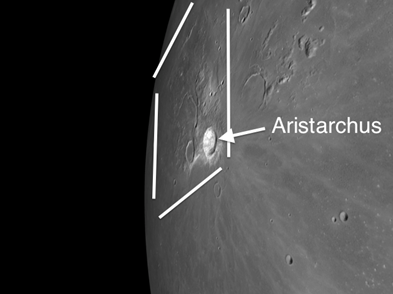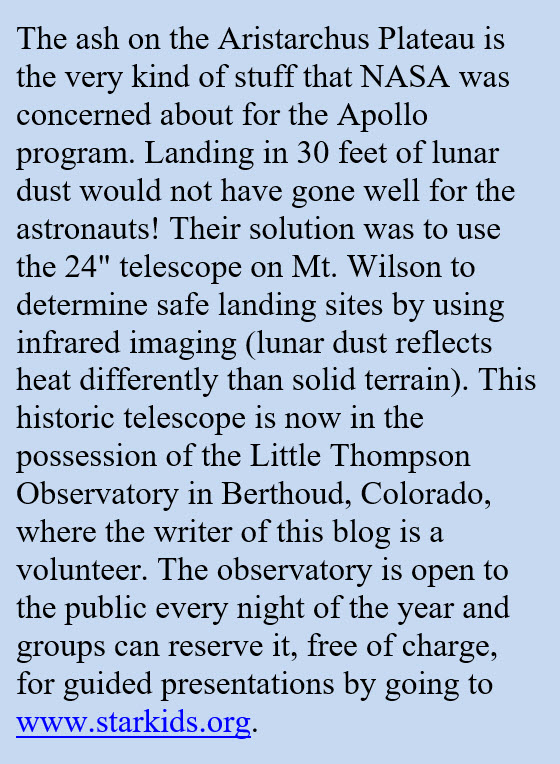The week of August 2-8 takes us from Lunar Day 25 to Day 1. This week we will highlight the Aristarchus Plateau and moon crater Aristarchus.

 Aristarchus Plateau: [NW/G4-5] This plateau is a diamond-shaped feature with straight sides measuring 100 x 125 miles and is over a mile higher than the surrounding mare areas. It is conjectured that the plateau was uplifted because of the pressures exerted by underground magma. It is an unusual object not only because of its straight sides but because it is covered by a mantle of pink-colored pyroclastic ash 30 to 100 feet thick. The Plateau has attracted the attention of NASA as an area for lunar colonization because hydrogen and oxygen can be extracted from the ash, providing fuel, water, and breathable air.
Aristarchus Plateau: [NW/G4-5] This plateau is a diamond-shaped feature with straight sides measuring 100 x 125 miles and is over a mile higher than the surrounding mare areas. It is conjectured that the plateau was uplifted because of the pressures exerted by underground magma. It is an unusual object not only because of its straight sides but because it is covered by a mantle of pink-colored pyroclastic ash 30 to 100 feet thick. The Plateau has attracted the attention of NASA as an area for lunar colonization because hydrogen and oxygen can be extracted from the ash, providing fuel, water, and breathable air.
The reddish color of the plateau is distinctive and sets it apart from the gray of the surrounding terrain. (Other observers see greenish or yellowish tones. What do you see?)
Aristarchus: [NW/G5] Aristarchus is the brightest spot on the Moon, a phenomenon that you observed on Day 3 when you may have noticed that you could see it even on the dark portion of the Moon! It is so bright that Sir William Herschel mistook it for an erupting volcano1. Try to draw the dark radial bands that climb straight up the west wall of Aristarchus. Some observers have reported up to nine bands. How many can you see? Do the bands creep up the wall and spill over onto the lunar terrain beyond?
1 William Herschel: 18th c. English astronomer who discovered Uranus.
======================
It is highly recommended that you get a copy of Sky and Telescope’s Field Map of the Moon, the very finest Moon map available for use at the telescope. It is available for $10.95 at www.skyandtelescope.com and on Amazon. All features mentioned in this blog will be keyed to the grid on the Field Map and will look like this: Plato: [NW/D9]
Credits:
Courtesy of Gray Photography of Corpus Christi, Texas
Lunar photos: NASA / USGS / BMDO / LROC / ASU / DLR / LOLA / Moon Globe. Used by permission
- Rupes Cauchy: A Best Known Fault on the Moon - July 22, 2024
- Moon Crater Schickard – Crater Floor has Stripes - July 15, 2024
- Moon Craters Langrenus and Vandelinus - July 8, 2024